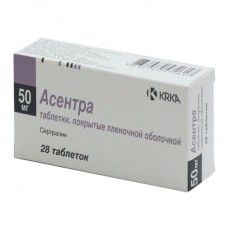Expiration date: 01/2026
Structure and Composition:
Film-coated tablets. 1 tablet contains sertraline hydrochloride 55.95 mg (Corresponding to 50 mg of sertraline)
Excipients: calcium dihydrogen MCC sodium carboxymethyl starch, magnesium stearate talc hydroxypropylcellulose.
shell structure: Opadry 03H28758 (ready-to-use mixture of hypromellose, titanium dioxide, talc, propylene glycol)
in contour cell packages on 7 pcs. 4 In the paper cartons packaging.
Description pharmaceutical form:
Round tablets, film-coated white with a beveled edge and a notch on one side.
Pharmacokinetics:
Absorbed in the intestine to a significant extent, but slowly. Cmax plasma levels achieved through 4,5-8,4 hours after ingestion of the drug. The equilibrium sertraline concentration in plasma is achieved within weeks after a single daily intake. Bioavailability when taken with food is increased by 25%, while the time to reach maximum concentration is shortened.
Distribution. Total binding of sertraline with proteins is 98%. The volume of distribution -> 20 l / kg.
Metabolism and excretion. Sertraline is extensively metabolized during the first passage through the liver, subjected to N-demethylation. Its main metabolite - N-desmetilsertralin less active as compared to the parent compound.
The metabolites are excreted with urine and feces in equivalent amounts. About 0.2% of sertraline excreted by the kidneys unchanged. T1 / 2 hours 22-36 of the drug is not dependent on age or gender. For N-desmetilsertralina this figure is 62-104 hours.
T1 / 2 of sertraline and the area under the concentration-time curve in plasma (AUC) increases with abnormal liver function. Regardless of the severity of renal failure the pharmacokinetics of sertraline in his constant use is not changed. Sertraline passes into breast milk. Data about its ability to pass through the blood-barrier is not.
Sertraline is not dialyzed.
Description of the pharmacological actions:
Mechanism of action. Sertraline - specific inhibitor of the reuptake of serotonin (5-HT). He has very little effect on the reuptake of noradrenaline and dopamine. At therapeutic doses, sertraline blocks uptake of serotonin in human platelets. He has no stimulating, sedative or anticholinergic action. Sertraline has no affinity for muscarinic (cholinergic), serotonergic, dopaminergic, adrenergic, histaminergic, GABA or benzodiazepine receptors.
Antidepressant effect was seen at the end of the second week of the regular intake of sertraline, while the maximum effect is achieved only after 6 weeks. Unlike tricyclic antidepressants, sertraline when assigning no increase in body weight. Sertraline does not cause mental or physical drug dependence.
Testimony:
- treatment and prevention of depression of various etiologies, including accompanied by a sense of anxiety
- obsessive-compulsive disorder (OCD)
- panic disorder
- post-traumatic stress disorder (PTSD).
Contraindications:
- Hypersensitivity to the active substance or any other ingredients in the drug
- concomitant use of sertraline and MAOIs (monoamine oxidase). When replacing one drug to another should avoid antidepressants within 14 days
- concomitant use of sertraline with tryptophan or fenfluramine
- unstable epilepsy
- pregnancy
- lactation
- Children up to age 6 years.
Carefully:
- neurological disorders (including mental retardation)
- mania
- epilepsy
- liver and / or kidney failure
- body mass reduction
- children older than 6 years.
Application of pregnancy and breastfeeding:
Monitored results of the application of sertraline in pregnant women do not have, so the drug should assign them only if the expected benefit to the mother outweighs the potential risk to the fetus.
Sertraline is found in breast milk, therefore the treatment with this drug is not recommended during breast-feeding. No reliable data on safety of its use in this case. If treatment is necessary, it is better to stop breast-feeding.
Side effect:
On the part of the digestive system: dry mouth, decreased appetite (rarely - increased) up to anorexia, dyspepsia (bloating, nausea, vomiting, diarrhea or unstable stool, constipation), stomach cramps, abdominal pain, pancreatitis, hepatitis, jaundice or liver failure.
From the nervous system: drowsiness, headache, dizziness, tremors, insomnia, anxiety, agitation, hypomania, mania, akathisia, paresthesias, depression symptoms, hallucinations, aggression, agitation, anxiety, psychosis, gait abnormalities, extrapyramidal disorder, dyskinesia, tremor , convulsions. Movement disorders were more common in patients with indications of their presence in the history or concomitant use of antipsychotics.
With the genitourinary system: delayed ejaculation, decreased libido, erectile dysfunction, anorgasmia, menstrual disorders, gynaecomastia, priapism, hyperprolactinemia, galactorrhea.
From the respiratory system: asthma, or a sense of compression of the thorax.
Cardio-vascular system: palpitation, chest pain, hypertension, hypotension, edema, syncope and tachycardia (very rare).
From the senses: visual disturbances (including blurred vision).
Allergic reactions: skin redness, hives, swelling of the eyelids, face or lips, skin rash, generalized pruritus, erythema multiforme exudative.
Laboratory data: reversible increases in transaminases, thrombocytopenia, leukopenia, transient hyponatremia (syndrome of inappropriate secretion antidiuriticheskogo hormone, more often in elderly patients, as well as when taking diuretics or some other drugs).
Other: sporadic bleeding (including epistaxis), hypothyroidism, increased sweating, weight loss, weakness, yawning, flushing. "Cancellation" syndrome may occur when stopping treatment with sertraline.
Drug Interactions:
MAO inhibitors. There have been severe complications, while the use of sertraline and MAO inhibitors (including the selective MAO inhibitors with a reversible type of action - selegiline and moclobemide). Perhaps the development of serotonin syndrome. Similar complications, sometimes fatal, occur in the appointment of MAO inhibitors during treatment with antidepressants, depressing neuronal uptake of monoamines or immediately after their withdrawal.
With simultaneous use of selective inhibitors of reverse neyronalnogo serotonin and MAO inhibitors arise: hyperthermia, rigidity, seizures, myoclonus, lability of the autonomic nervous system (rapid fluctuations in the parameters of the respiratory and cardiovascular system), mental status changes, including increased irritability, expressed excitement, confusion consciousness, which in some cases can go into delirious state or coma.
Drugs that suppress the central nervous system, and ethanol. The combined use of sertraline and substances which depress the central nervous system requires attention, it is also prohibited the use of alcoholic beverages during treatment with sertraline.
Coumarin derivatives. At their joint appointment with sertraline showed a significant increase in the PV. In these cases it is recommended to control the PV at the beginning of treatment with sertraline and after its cancellation.
Pharmacokinetic interactions
Sertraline is bound to plasma proteins. It is therefore necessary to consider the possibility of interaction with other drugs that bind to the protein (eg diazepam, tolbutamide and warfarin).
Cimetidine. Simultaneous application substantially reduces the clearance of sertraline.
Drugs metabolized isoenzyme cytochrome P450 2D6. Long-term treatment with sertraline 50 mg / day accompanied by an increase desipramine concentrations.
Drugs metabolized by cytochrome P450 other enzyme systems. Experiments on the interaction in vitro showed that the isoenzymes carried CYP 3A3 / 4 beta-hydroxylation of endogenous cortisol, as well as the metabolism of carbamazepine and long-term administration of terfenadine with sertraline at a dose of 200 mg / day does not change. The concentration in the blood plasma tolbutamide, warfarin and phenytoin prolonged assignment of sertraline in the same dose also varies. Thus, we can conclude that sertraline does not inhibit the isoenzymes CYP2C9.
Sertraline has no effect on the concentration of diazepam in blood serum, which indicates the absence of inhibition of isoenzymes CYP 2C19. According to studies in vitro, sertraline has virtually no effect or minimally inhibits isoenzyme CYP 1A2.
Lithium. The pharmacokinetics of lithium is not changed by concomitant administration of sertraline. However, in their joint application tremor occurs more frequently. As well as the appointment of other selective inhibitors of reverse neuronal serotonin reuptake, sertraline joint application with drugs that affect the serotonergic transmission (eg lithium), requires increased caution.
Agents acting on serotonergic transmission. in "laundering" period, when replacing one inhibitor of neuronal serotonin reuptake to another is not necessary. However, you want to be careful with changes in the course of treatment. Avoid concomitant administration of tryptophan or fenfluramine with sertraline.
Induction of hepatic microsomal enzymes. Sertraline causes minimal induction of liver enzymes. Co-administration of sertraline and antipyrine at a dose of 200 mg leads to a significant decrease in T1 / 2 of antipyrine (differs by only 5% of cases).
Atenolol. If co-administration of sertraline does not change its beta-adrenoceptor blocking action.
Glibenclamide and digoxin. With the introduction of sertraline in a daily dose of 200 mg of drug interactions with these drugs have been identified.
Dosage and administration:
Inside.
For depression and OCD in adults average starting dose is 50 mg 1 time a day, morning or evening. The daily dose can be gradually, not earlier than one week, increasing to 50 mg up to a maximum daily dose of 200 mg.
When panic and post-traumatic stress disorder Asentry starting dose is 25 mg 1 time a day, morning or evening. After one week the dose can be increased to 50 mg once a day 1, and then gradually, not earlier than one week increased to a maximum daily dose of 200 mg.
Satisfactory therapeutic results achieved typically after 7 days of starting treatment. However, to achieve full therapeutic benefit regular intake of the drug is required for 2-4 weeks. In patients with OCD in order to achieve a good result may require 8-12 weeks. The minimum dose providing therapeutic effect is maintained in the future as a support.
Asentry initial dose for children aged 6 to 12 years is 25 mg sertraline, 1 time a day, morning or evening. After one week the dose can be increased to 50 mg 1 time per day. For children aged 12 to 17 years starting dose is 50 mg 1 time per day in the morning or in the evening. If necessary, the daily dose can be gradually, not earlier than one week, to raise to a maximum of 50 mg daily dose of 200 mg. To avoid overdose should take into account the smaller body weight in children than adults, and by increasing the dose of 50 mg / day should be carefully monitored for this category of patients, and the drug should be discontinued at the first sign of overdose.
In elderly patients there is no need a special dose adjustment.
When violations of liver function The drug should be used with caution. In severe hepatic dysfunction dose should be reduced or increased intervals between doses.
Patients with impaired renal function, a special correction dosing regime is not required.
Overdose:
Symptoms: serotonin syndrome - nausea, vomiting, drowsiness, ECG changes, mydriasis, tachycardia, agitation, dizziness, anxiety, agitation, diarrhea, increased sweating, myoclonus and hyperreflexia.
Treatment: symptomatic maintenance of normal airway (oxygenation and ventilation) and monitoring of cardiac rhythm and vital organs and systems. Induce vomiting is not recommended. Purpose of activated charcoal and sorbitol may be more efficient than a gastric lavage. No specific antidote. At the large volume of distribution of sertraline, in this regard, increased diuresis, dialysis, hemoperfusion or blood transfusion may be unsuccessful.
Special instructions:
Sertraline should not be administered together with MAO inhibitors and within 14 days after discontinuation of treatment MAO inhibitors. Similarly, after the abolition of sertraline for 14 days did not prescribe MAOIs.
It should be noted that in patients undergoing electroconvulsive therapy, sufficient experience with sertraline is not. The possible success or the risk of such combined treatment has not been studied. Patients with depression are at risk for suicide attempts. This risk persists until the development of remission. Therefore, from the beginning of the treatment and to achieve optimal clinical response for patients should establish a permanent medical supervision.
Women of childbearing age during treatment should use adequate contraception methods.
Effects on ability to drive vehicles and management mechanisms. Appointment of sertraline is usually not accompanied by violation of psychomotor functions. However, its use in conjunction with other drugs may impair attention and motor coordination. Therefore, during treatment with sertraline drive vehicles, special equipment or practice associated with an increased risk of the activity is not recommended.


